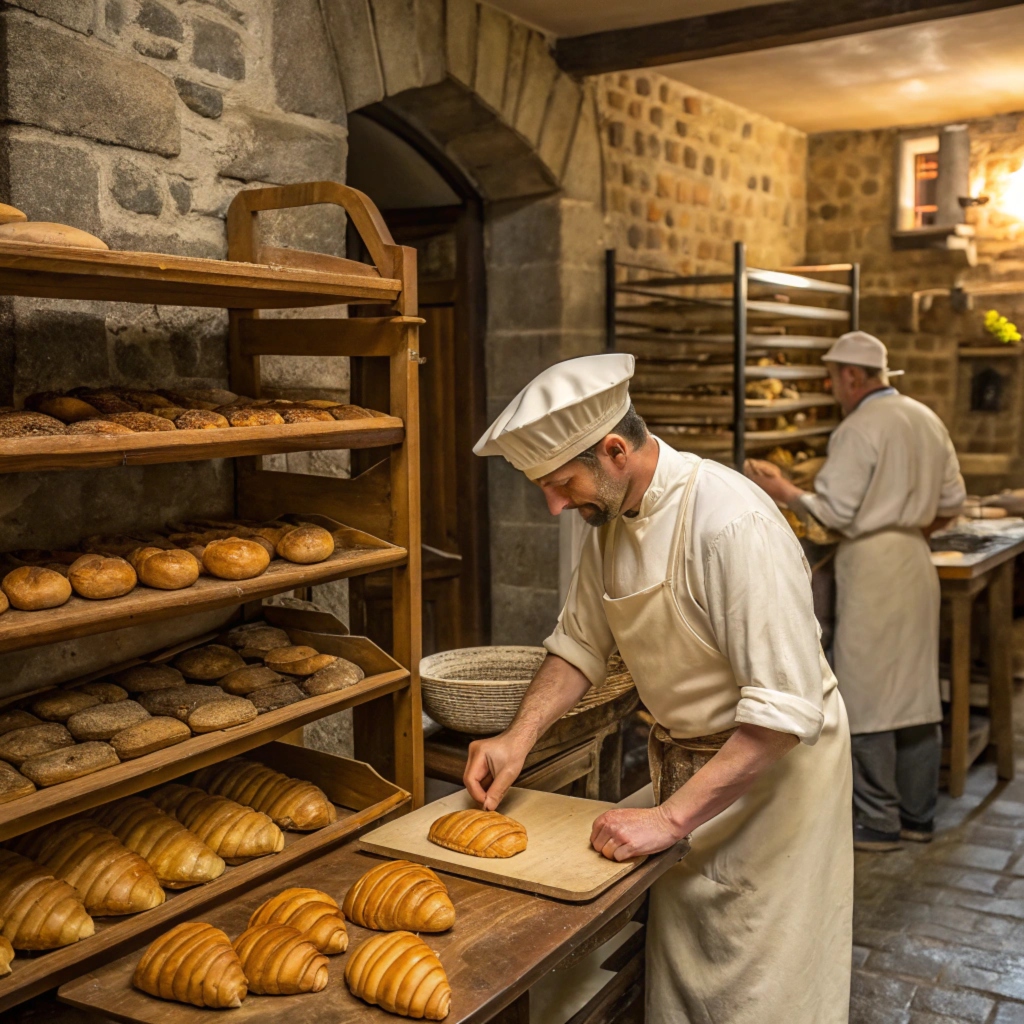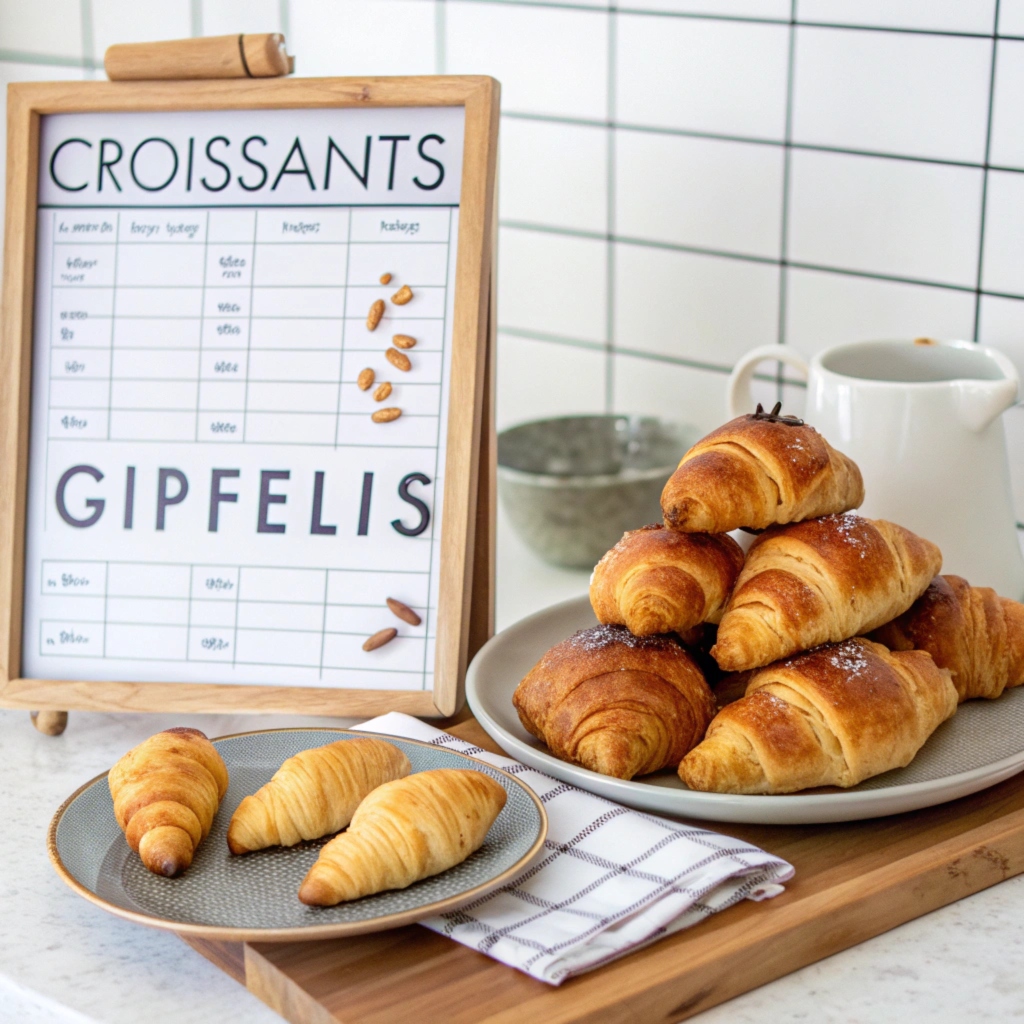When it comes to breakfast pastries, the croissant and the gipfeli are often confused, but these two delicacies couldn’t be more different. Whether you’re savoring a buttery croissant in a quaint French café or biting into a hearty Swiss gipfeli during a ski trip, each pastry offers its own unique experience. So, what really sets them apart? What is the difference between a croissant and a gipfeli? Let’s dig in!
Pastries are universal treats, but the croissant and gipfeli hold a special place in French and Swiss cultures, respectively. They may look similar at first glance, but once you take a closer look (or bite), the distinctions become clear. While croissants are celebrated for their buttery, flaky layers, gipfelis lean toward a simpler, firmer structure. But their differences go beyond texture—they’re rooted in history, tradition, and taste.
Table of contents
“Think of croissants as the sophisticated ballet dancer of pastries, while gipfelis are more like the sturdy hiker: both elegant, but in very different ways.”
History and Origins

French Beginnings of the Croissant
The croissant has long been a symbol of French culture, but its story starts with an Austrian influence. The origins trace back to the kipferl, a crescent-shaped bread introduced to France in the 17th century. French bakers reimagined the kipferl by adding layers of butter and folding the dough—a process called lamination. This innovation gave birth to the flaky masterpiece we know today.
Croissants quickly became a breakfast staple in Parisian bakeries and gained international fame. Their luxurious texture and golden hue make them irresistible, whether eaten plain or filled with chocolate or almond paste.
Swiss Heritage of the Gipfeli
Meanwhile, the gipfeli—Switzerland’s answer to the croissant—has its own fascinating background. The word “gipfeli” comes from the German word Gipfel, meaning “peak,” which explains its signature crescent shape resembling mountain tops. Swiss bakers preferred a less buttery, firmer texture that aligned with their practical, no-nonsense culinary style.
Gipfelis are beloved for their subtle sweetness and satisfying chew. They’re often paired with coffee or jam and enjoyed as part of a hearty Swiss breakfast. Unlike the croissant, gipfelis are less extravagant but no less delicious.
Key Differences in Taste and Texture
Flaky Layers of the Croissant
Imagine peeling apart a croissant—its layers practically whispering luxury. That’s the magic of its lamination process, where layers of dough and butter are folded multiple times. This technique creates the airy, flaky texture croissants are famous for. When you bite into one, it feels like biting into a buttery cloud.
Denser Feel of the Gipfeli
On the other hand, a gipfeli doesn’t aim for lightness; it goes for substance. Its dough, while still soft, has a denser crumb. The texture is firmer, making it ideal for those who prefer a pastry that holds up well with fillings or spreads.
“Think of a croissant as a fluffy pillow and a gipfeli as a cozy blanket—both comforting, but in their own way.”
Nutritional Facts and Health Considerations

Calorie Content in Croissants
Croissants are notoriously indulgent. A single croissant can pack anywhere from 230 to 300 calories, depending on its size and the amount of butter used. While this might not seem alarming for a treat, the saturated fat content is something to keep in mind.
Calorie Content in Gipfelis
Gipfelis, while also calorie-dense, tend to contain slightly less butter. This makes them a marginally lighter option. A gipfeli typically ranges from 180 to 250 calories, offering a more practical choice for those watching their fat intake.
Baking, Cultural Significance, and Common Misconceptions
Baking Techniques: How They’re Made
The differences between croissants and gipfelis start in the bakery. Each requires unique techniques that influence its texture, taste, and final form.
Traditional Method for Croissants
Creating a croissant is truly an art. The process involves laminating dough, where layers of butter are folded into the dough multiple times. This creates the signature flaky texture. The dough is then shaped into crescents, proofed to rise, and baked until golden brown. The result? A melt-in-your-mouth pastry that feels like a warm hug on a chilly morning.
Key ingredients for croissants include:
- Flour
- Yeast
- Butter (lots of it!)
- Milk or water
- A touch of sugar
The secret lies in the lamination technique and the butter’s quality. High-fat butter ensures those rich, tender layers that croissants are known for.
Traditional Method for Gipfelis
Making a gipfeli is a slightly simpler process. While the dough is still folded, it isn’t laminated as extensively as croissant dough. This results in a firmer, denser texture. Gipfelis are also smaller and less buttery, which gives them their distinctive flavor.
Swiss bakers often flavor gipfelis with a hint of honey or malt extract, adding a subtle sweetness that sets them apart. The dough is rolled into crescents, proofed, and baked to perfection, leaving a delightful aroma in every Swiss kitchen.
“If croissants are a symphony, gipfelis are a folk tune—both beautiful, but with different levels of complexity.”
Common Misconceptions About Croissants and Gipfelis
Let’s clear up some myths!
- “Are Gipfelis Just Croissants Under a Different Name?”
Nope! While they may look alike, their taste and texture tell a different story. Gipfelis are less buttery and not as flaky, offering a more subtle flavor. - “Do Croissants Always Contain Butter?”
Yes, and that’s what makes them so rich. However, some variations like croissants au beurre (pure butter) and croissants ordinaires (made with margarine) can differ slightly. - “Are Gipfelis Meant to Be Eaten Plain?”
Not necessarily. While they’re delicious as is, gipfelis pair beautifully with jam, honey, or even cheese.
Cultural Significance and Popularity
Croissant as a French Culinary Icon
Few things scream “France” like a croissant. It’s a breakfast staple, a café treat, and a culinary ambassador for French culture. Croissants are not just pastries; they’re an experience. From the way they flake with every bite to their warm, buttery aroma, they embody indulgence.
In France, croissants are often enjoyed alongside a café au lait or an espresso, making mornings feel luxurious. Their popularity has transcended borders, with croissants becoming a global sensation.
Gipfeli in Swiss Breakfast Culture
Gipfelis, on the other hand, hold a special place in Swiss hearts. They’re a symbol of practicality and tradition. Whether grabbed on the go or enjoyed leisurely with a cup of Swiss hot chocolate, gipfelis are a breakfast favorite.
Swiss hotels and bakeries often serve gipfelis as part of their morning offerings, highlighting their significance in Swiss breakfast culture. Unlike croissants, they’re seen as less of a luxury and more of a comforting everyday treat.
Serving Suggestions and Pairings
Perfect Beverages to Pair With Croissants
- Café au lait: The creamy richness complements the buttery layers.
- Espresso: A bold shot of espresso cuts through the richness.
- Hot chocolate: Perfect for kids or those with a sweet tooth.
What Goes Best With a Gipfeli?
- Swiss hot chocolate: A match made in breakfast heaven.
- Fruit jams: The subtle sweetness of a gipfeli pairs well with tangy jams like apricot or raspberry.
- Cheese: For a savory twist, try spreading soft cheese on a gipfeli.
Frequently Asked Questions (FAQs)
Can You Substitute a Croissant for a Gipfeli?
Technically, yes, but it depends on the context. Croissants and gipfelis serve different purposes in terms of taste and texture. For recipes or meals that require a buttery, flaky texture (like sandwiches or dessert bases), croissants are ideal. Gipfelis, with their denser structure, are better suited for hearty, spread-based breakfasts or as standalone snacks.
If you’re looking for a croissant’s luxurious feel, a gipfeli might not deliver. However, if you need a more practical and less buttery alternative, the gipfeli steps up wonderfully.
Which Is Better for Health-Conscious Individuals?
Gipfelis tend to have fewer calories and less butter compared to croissants, making them a slightly lighter option. If you’re watching your saturated fat intake, gipfelis might be the better choice. Croissants, while delicious, are undeniably indulgent due to their high butter content.
That said, both are treats best enjoyed in moderation. Balance them with fresh fruits, lean proteins, or whole grains for a well-rounded meal.
Why Are Croissants More Popular Globally?
Croissants owe their global fame to French culture’s worldwide influence. As a symbol of elegance and indulgence, croissants have captured the imagination (and taste buds) of people around the world. Their buttery, flaky texture is hard to resist, and they’re versatile enough to be sweet or savory.
Gipfelis, while beloved in Switzerland, have a more localized appeal. Their simpler texture and flavor haven’t achieved the same level of international acclaim, but that doesn’t make them any less delicious.
“Croissants may be the spotlight performer, but gipfelis are the dependable understudy—always there when you need them.”
More Ideas
1. Croissant and Gipfeli Recipe Ideas
- How to Make the Perfect Gipfeli: Recipe, Ideas, Pairings, Tips
Learn step-by-step how to bake your own delicious Gipfelis at home and discover perfect pairings. - Secret to Super Moist Cake
Explore techniques to keep pastries like Gipfelis or cakes soft and moist.
2. Pastry Ingredient Comparisons
- Difference Between Marzipan and Almond Paste
Dive into the differences between other baking essentials, similar to croissants vs. gipfelis. - Baking with Almond Flour
Find out how alternative flours like almond flour can influence pastry texture and flavor.
3. Origins and Cultural Significance
- What Is Sassy Scotty? A Scottish Terrier Guide
A fun cultural exploration, tying in with how Gipfelis represent Swiss tradition.
4. Perfect Pairings
- What Flavor Goes Well with Almond Cake?
Discover flavor combinations that can inspire croissant and gipfeli pairings.
5. Additional Pastry Techniques and Comparisons
- Difference Between Crème Brûlée and Custard
A detailed breakdown of two similar desserts—perfect for readers interested in comparisons like croissants vs. gipfelis. - Secret to Perfect Crème Brûlée
For fans of delicate desserts like croissants, this guide will resonate well.
6. Breakfast and Pastry Health Insights
- Is Pastalaya Healthy?
Explore health insights for breakfast and main meal options, similar to assessing croissant vs. gipfeli nutrition.
Proposed New Content Ideas
Based on these URLs, consider creating content like:
- “How Gipfelis Compare to Other European Pastries”
- “Breakfast Around the World: Croissants vs. Local Favorites”
- “Pairing Swiss Hot Chocolate with Gipfelis: A Perfect Match”
Conclusion: Croissant vs. Gipfeli – Final Thoughts
When it comes to croissants and gipfelis, there’s no “better” option—just personal preference. Croissants are luxurious and flaky, perfect for a slow morning with a cappuccino or as a decadent treat. Gipfelis, on the other hand, are the practical, no-fuss pastries that bring a taste of Swiss tradition to your breakfast table.
Whether you’re indulging in a buttery croissant or enjoying the simplicity of a gipfeli, both pastries remind us of the joys of baking and the cultural stories they carry. So why choose one when you can enjoy both? After all, life is better with more pastries. 🥐✨
